Dissertation on Conflict Management and Negotiation Strategies
VerifiedAdded on 2020/10/22
|23
|5819
|300
Dissertation
AI Summary
This dissertation explores conflict management and negotiation strategies within a business context. The introduction defines conflict management and its importance, highlighting the role of negotiation in resolving conflicts and improving team performance. The dissertation outlines aims and objectives, including identifying positive and negative aspects of conflict management and the relationship between conflict management and negotiation. A literature review examines different authors' viewpoints on conflict management and negotiation. The methodology section describes the participants, data collection procedures (primary and secondary), and data analysis procedures (qualitative and thematic analysis). The dissertation uses an online survey with 17 participants for data collection. The results and discussion sections analyze the findings, and the conclusion provides recommendations for improving team performance through effective conflict management. The study emphasizes the importance of understanding and managing conflicts constructively to foster learning, improve relationships, and enhance team efficiency, highlighting the benefits of negotiation as a conflict resolution tool.

Dissertation
Paraphrase This Document
Need a fresh take? Get an instant paraphrase of this document with our AI Paraphraser
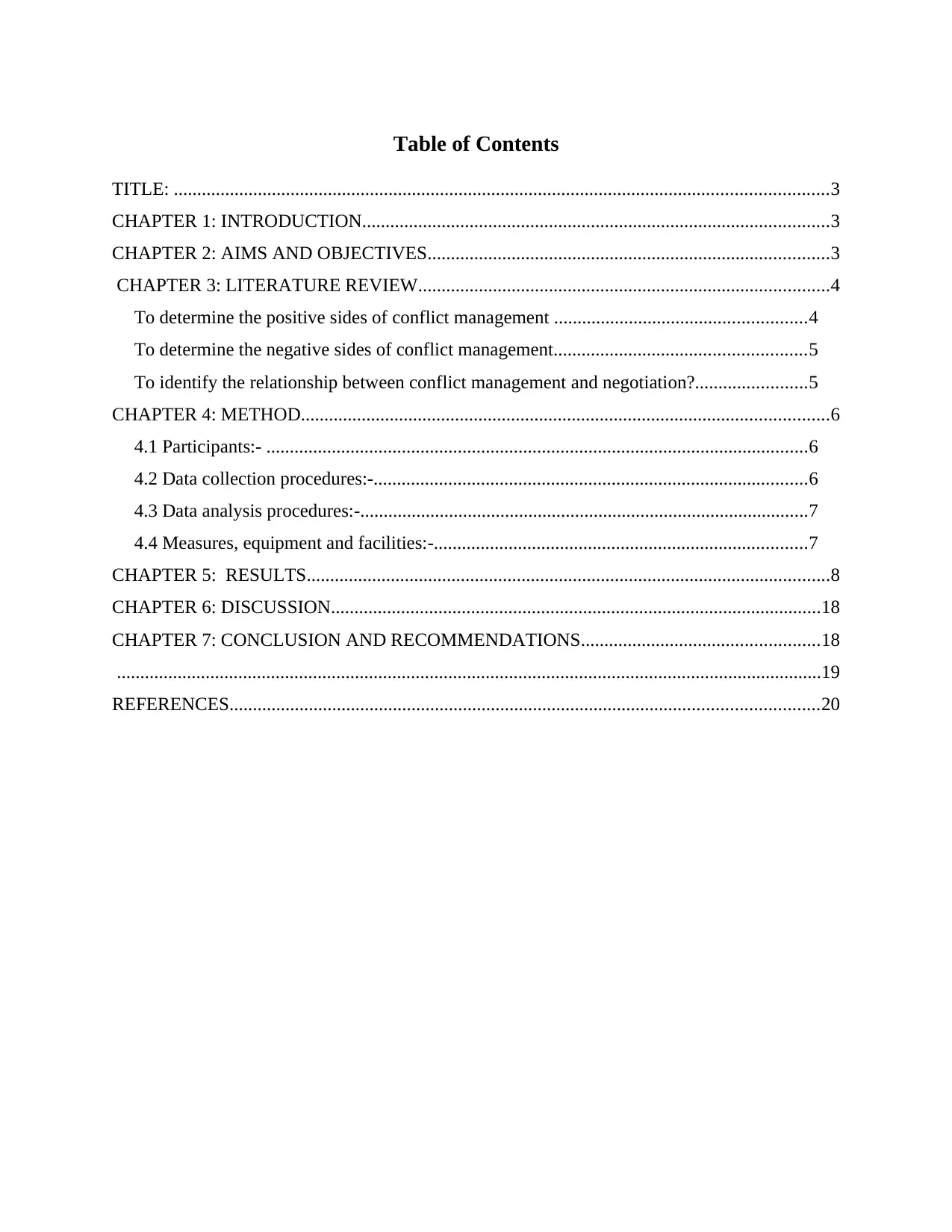
Table of Contents
TITLE: ............................................................................................................................................3
CHAPTER 1: INTRODUCTION....................................................................................................3
CHAPTER 2: AIMS AND OBJECTIVES......................................................................................3
CHAPTER 3: LITERATURE REVIEW........................................................................................4
To determine the positive sides of conflict management ......................................................4
To determine the negative sides of conflict management......................................................5
To identify the relationship between conflict management and negotiation?........................5
CHAPTER 4: METHOD.................................................................................................................6
4.1 Participants:- ....................................................................................................................6
4.2 Data collection procedures:-.............................................................................................6
4.3 Data analysis procedures:-................................................................................................7
4.4 Measures, equipment and facilities:-................................................................................7
CHAPTER 5: RESULTS................................................................................................................8
CHAPTER 6: DISCUSSION.........................................................................................................18
CHAPTER 7: CONCLUSION AND RECOMMENDATIONS...................................................18
.......................................................................................................................................................19
REFERENCES..............................................................................................................................20
TITLE: ............................................................................................................................................3
CHAPTER 1: INTRODUCTION....................................................................................................3
CHAPTER 2: AIMS AND OBJECTIVES......................................................................................3
CHAPTER 3: LITERATURE REVIEW........................................................................................4
To determine the positive sides of conflict management ......................................................4
To determine the negative sides of conflict management......................................................5
To identify the relationship between conflict management and negotiation?........................5
CHAPTER 4: METHOD.................................................................................................................6
4.1 Participants:- ....................................................................................................................6
4.2 Data collection procedures:-.............................................................................................6
4.3 Data analysis procedures:-................................................................................................7
4.4 Measures, equipment and facilities:-................................................................................7
CHAPTER 5: RESULTS................................................................................................................8
CHAPTER 6: DISCUSSION.........................................................................................................18
CHAPTER 7: CONCLUSION AND RECOMMENDATIONS...................................................18
.......................................................................................................................................................19
REFERENCES..............................................................................................................................20
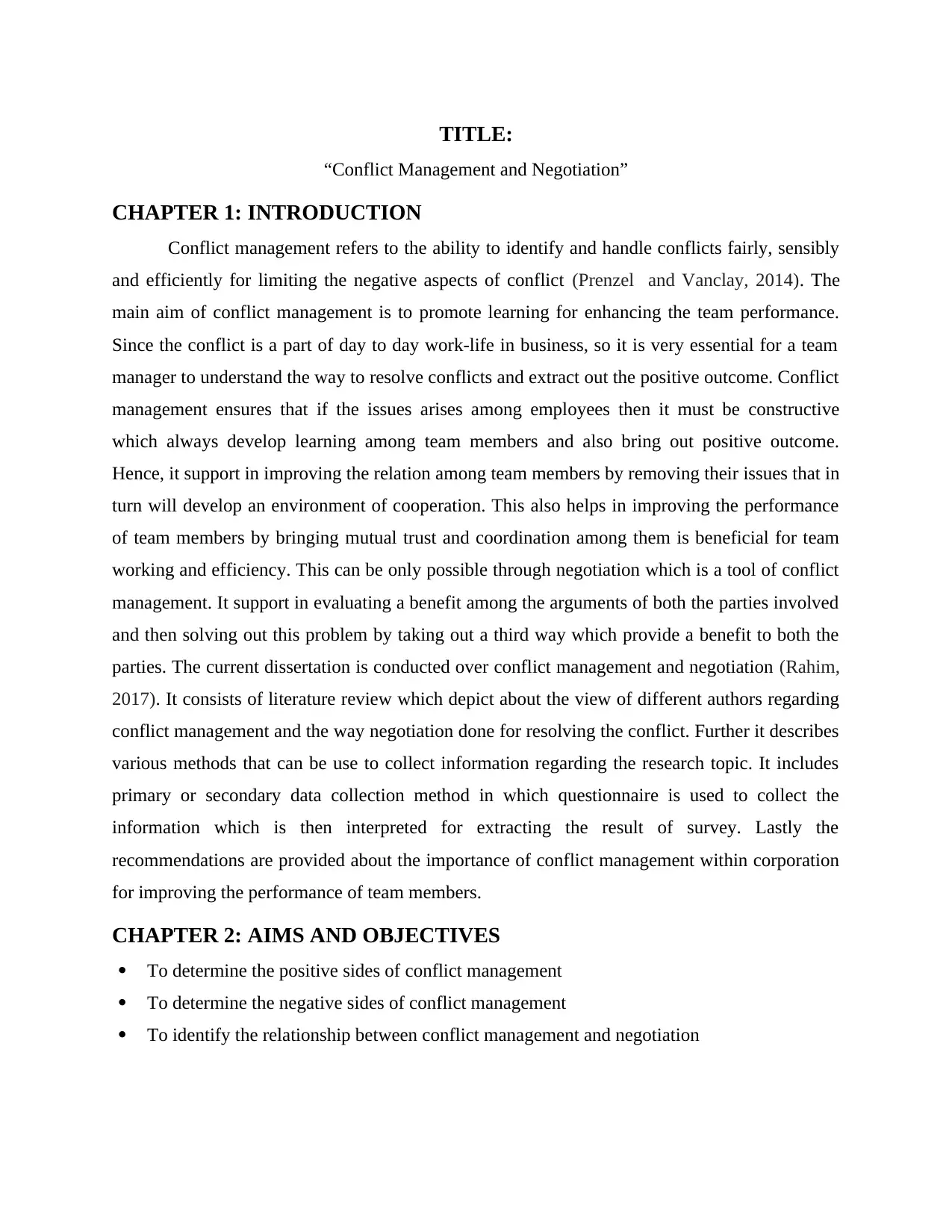
TITLE:
“Conflict Management and Negotiation”
CHAPTER 1: INTRODUCTION
Conflict management refers to the ability to identify and handle conflicts fairly, sensibly
and efficiently for limiting the negative aspects of conflict (Prenzel and Vanclay, 2014). The
main aim of conflict management is to promote learning for enhancing the team performance.
Since the conflict is a part of day to day work-life in business, so it is very essential for a team
manager to understand the way to resolve conflicts and extract out the positive outcome. Conflict
management ensures that if the issues arises among employees then it must be constructive
which always develop learning among team members and also bring out positive outcome.
Hence, it support in improving the relation among team members by removing their issues that in
turn will develop an environment of cooperation. This also helps in improving the performance
of team members by bringing mutual trust and coordination among them is beneficial for team
working and efficiency. This can be only possible through negotiation which is a tool of conflict
management. It support in evaluating a benefit among the arguments of both the parties involved
and then solving out this problem by taking out a third way which provide a benefit to both the
parties. The current dissertation is conducted over conflict management and negotiation (Rahim,
2017). It consists of literature review which depict about the view of different authors regarding
conflict management and the way negotiation done for resolving the conflict. Further it describes
various methods that can be use to collect information regarding the research topic. It includes
primary or secondary data collection method in which questionnaire is used to collect the
information which is then interpreted for extracting the result of survey. Lastly the
recommendations are provided about the importance of conflict management within corporation
for improving the performance of team members.
CHAPTER 2: AIMS AND OBJECTIVES
To determine the positive sides of conflict management
To determine the negative sides of conflict management
To identify the relationship between conflict management and negotiation
“Conflict Management and Negotiation”
CHAPTER 1: INTRODUCTION
Conflict management refers to the ability to identify and handle conflicts fairly, sensibly
and efficiently for limiting the negative aspects of conflict (Prenzel and Vanclay, 2014). The
main aim of conflict management is to promote learning for enhancing the team performance.
Since the conflict is a part of day to day work-life in business, so it is very essential for a team
manager to understand the way to resolve conflicts and extract out the positive outcome. Conflict
management ensures that if the issues arises among employees then it must be constructive
which always develop learning among team members and also bring out positive outcome.
Hence, it support in improving the relation among team members by removing their issues that in
turn will develop an environment of cooperation. This also helps in improving the performance
of team members by bringing mutual trust and coordination among them is beneficial for team
working and efficiency. This can be only possible through negotiation which is a tool of conflict
management. It support in evaluating a benefit among the arguments of both the parties involved
and then solving out this problem by taking out a third way which provide a benefit to both the
parties. The current dissertation is conducted over conflict management and negotiation (Rahim,
2017). It consists of literature review which depict about the view of different authors regarding
conflict management and the way negotiation done for resolving the conflict. Further it describes
various methods that can be use to collect information regarding the research topic. It includes
primary or secondary data collection method in which questionnaire is used to collect the
information which is then interpreted for extracting the result of survey. Lastly the
recommendations are provided about the importance of conflict management within corporation
for improving the performance of team members.
CHAPTER 2: AIMS AND OBJECTIVES
To determine the positive sides of conflict management
To determine the negative sides of conflict management
To identify the relationship between conflict management and negotiation
⊘ This is a preview!⊘
Do you want full access?
Subscribe today to unlock all pages.

Trusted by 1+ million students worldwide
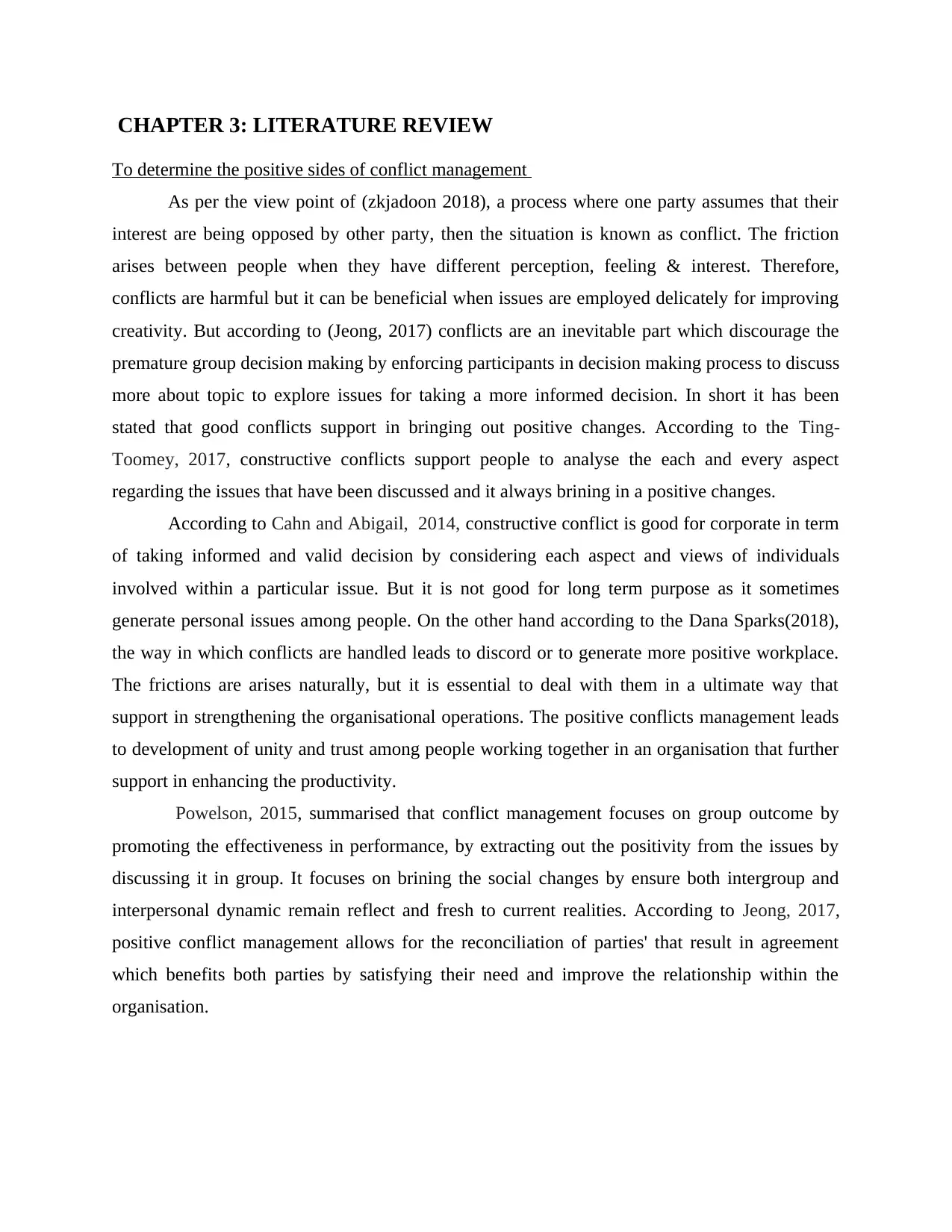
CHAPTER 3: LITERATURE REVIEW
To determine the positive sides of conflict management
As per the view point of (zkjadoon 2018), a process where one party assumes that their
interest are being opposed by other party, then the situation is known as conflict. The friction
arises between people when they have different perception, feeling & interest. Therefore,
conflicts are harmful but it can be beneficial when issues are employed delicately for improving
creativity. But according to (Jeong, 2017) conflicts are an inevitable part which discourage the
premature group decision making by enforcing participants in decision making process to discuss
more about topic to explore issues for taking a more informed decision. In short it has been
stated that good conflicts support in bringing out positive changes. According to the Ting‐
Toomey, 2017, constructive conflicts support people to analyse the each and every aspect
regarding the issues that have been discussed and it always brining in a positive changes.
According to Cahn and Abigail, 2014, constructive conflict is good for corporate in term
of taking informed and valid decision by considering each aspect and views of individuals
involved within a particular issue. But it is not good for long term purpose as it sometimes
generate personal issues among people. On the other hand according to the Dana Sparks(2018),
the way in which conflicts are handled leads to discord or to generate more positive workplace.
The frictions are arises naturally, but it is essential to deal with them in a ultimate way that
support in strengthening the organisational operations. The positive conflicts management leads
to development of unity and trust among people working together in an organisation that further
support in enhancing the productivity.
Powelson, 2015, summarised that conflict management focuses on group outcome by
promoting the effectiveness in performance, by extracting out the positivity from the issues by
discussing it in group. It focuses on brining the social changes by ensure both intergroup and
interpersonal dynamic remain reflect and fresh to current realities. According to Jeong, 2017,
positive conflict management allows for the reconciliation of parties' that result in agreement
which benefits both parties by satisfying their need and improve the relationship within the
organisation.
To determine the positive sides of conflict management
As per the view point of (zkjadoon 2018), a process where one party assumes that their
interest are being opposed by other party, then the situation is known as conflict. The friction
arises between people when they have different perception, feeling & interest. Therefore,
conflicts are harmful but it can be beneficial when issues are employed delicately for improving
creativity. But according to (Jeong, 2017) conflicts are an inevitable part which discourage the
premature group decision making by enforcing participants in decision making process to discuss
more about topic to explore issues for taking a more informed decision. In short it has been
stated that good conflicts support in bringing out positive changes. According to the Ting‐
Toomey, 2017, constructive conflicts support people to analyse the each and every aspect
regarding the issues that have been discussed and it always brining in a positive changes.
According to Cahn and Abigail, 2014, constructive conflict is good for corporate in term
of taking informed and valid decision by considering each aspect and views of individuals
involved within a particular issue. But it is not good for long term purpose as it sometimes
generate personal issues among people. On the other hand according to the Dana Sparks(2018),
the way in which conflicts are handled leads to discord or to generate more positive workplace.
The frictions are arises naturally, but it is essential to deal with them in a ultimate way that
support in strengthening the organisational operations. The positive conflicts management leads
to development of unity and trust among people working together in an organisation that further
support in enhancing the productivity.
Powelson, 2015, summarised that conflict management focuses on group outcome by
promoting the effectiveness in performance, by extracting out the positivity from the issues by
discussing it in group. It focuses on brining the social changes by ensure both intergroup and
interpersonal dynamic remain reflect and fresh to current realities. According to Jeong, 2017,
positive conflict management allows for the reconciliation of parties' that result in agreement
which benefits both parties by satisfying their need and improve the relationship within the
organisation.
Paraphrase This Document
Need a fresh take? Get an instant paraphrase of this document with our AI Paraphraser
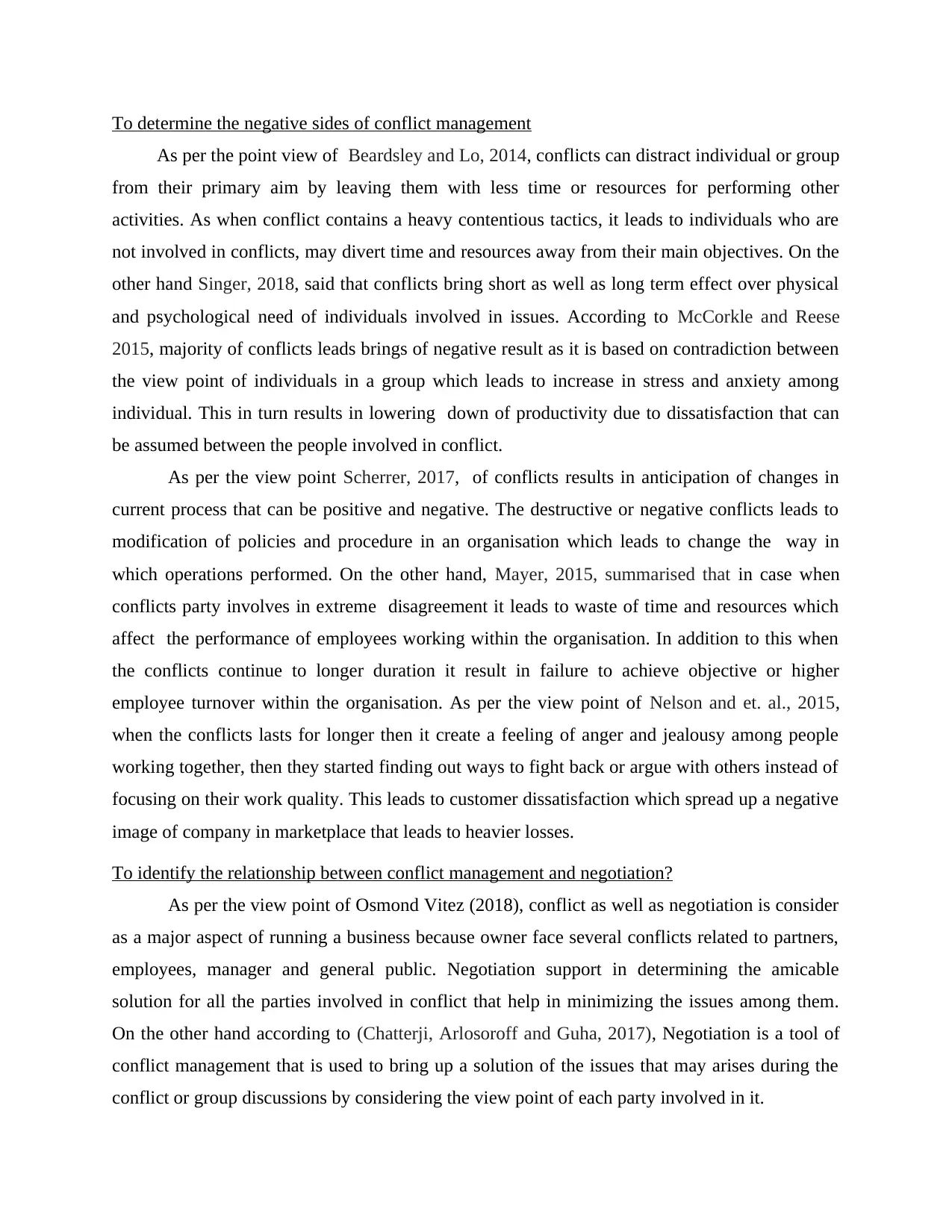
To determine the negative sides of conflict management
As per the point view of Beardsley and Lo, 2014, conflicts can distract individual or group
from their primary aim by leaving them with less time or resources for performing other
activities. As when conflict contains a heavy contentious tactics, it leads to individuals who are
not involved in conflicts, may divert time and resources away from their main objectives. On the
other hand Singer, 2018, said that conflicts bring short as well as long term effect over physical
and psychological need of individuals involved in issues. According to McCorkle and Reese
2015, majority of conflicts leads brings of negative result as it is based on contradiction between
the view point of individuals in a group which leads to increase in stress and anxiety among
individual. This in turn results in lowering down of productivity due to dissatisfaction that can
be assumed between the people involved in conflict.
As per the view point Scherrer, 2017, of conflicts results in anticipation of changes in
current process that can be positive and negative. The destructive or negative conflicts leads to
modification of policies and procedure in an organisation which leads to change the way in
which operations performed. On the other hand, Mayer, 2015, summarised that in case when
conflicts party involves in extreme disagreement it leads to waste of time and resources which
affect the performance of employees working within the organisation. In addition to this when
the conflicts continue to longer duration it result in failure to achieve objective or higher
employee turnover within the organisation. As per the view point of Nelson and et. al., 2015,
when the conflicts lasts for longer then it create a feeling of anger and jealousy among people
working together, then they started finding out ways to fight back or argue with others instead of
focusing on their work quality. This leads to customer dissatisfaction which spread up a negative
image of company in marketplace that leads to heavier losses.
To identify the relationship between conflict management and negotiation?
As per the view point of Osmond Vitez (2018), conflict as well as negotiation is consider
as a major aspect of running a business because owner face several conflicts related to partners,
employees, manager and general public. Negotiation support in determining the amicable
solution for all the parties involved in conflict that help in minimizing the issues among them.
On the other hand according to (Chatterji, Arlosoroff and Guha, 2017), Negotiation is a tool of
conflict management that is used to bring up a solution of the issues that may arises during the
conflict or group discussions by considering the view point of each party involved in it.
As per the point view of Beardsley and Lo, 2014, conflicts can distract individual or group
from their primary aim by leaving them with less time or resources for performing other
activities. As when conflict contains a heavy contentious tactics, it leads to individuals who are
not involved in conflicts, may divert time and resources away from their main objectives. On the
other hand Singer, 2018, said that conflicts bring short as well as long term effect over physical
and psychological need of individuals involved in issues. According to McCorkle and Reese
2015, majority of conflicts leads brings of negative result as it is based on contradiction between
the view point of individuals in a group which leads to increase in stress and anxiety among
individual. This in turn results in lowering down of productivity due to dissatisfaction that can
be assumed between the people involved in conflict.
As per the view point Scherrer, 2017, of conflicts results in anticipation of changes in
current process that can be positive and negative. The destructive or negative conflicts leads to
modification of policies and procedure in an organisation which leads to change the way in
which operations performed. On the other hand, Mayer, 2015, summarised that in case when
conflicts party involves in extreme disagreement it leads to waste of time and resources which
affect the performance of employees working within the organisation. In addition to this when
the conflicts continue to longer duration it result in failure to achieve objective or higher
employee turnover within the organisation. As per the view point of Nelson and et. al., 2015,
when the conflicts lasts for longer then it create a feeling of anger and jealousy among people
working together, then they started finding out ways to fight back or argue with others instead of
focusing on their work quality. This leads to customer dissatisfaction which spread up a negative
image of company in marketplace that leads to heavier losses.
To identify the relationship between conflict management and negotiation?
As per the view point of Osmond Vitez (2018), conflict as well as negotiation is consider
as a major aspect of running a business because owner face several conflicts related to partners,
employees, manager and general public. Negotiation support in determining the amicable
solution for all the parties involved in conflict that help in minimizing the issues among them.
On the other hand according to (Chatterji, Arlosoroff and Guha, 2017), Negotiation is a tool of
conflict management that is used to bring up a solution of the issues that may arises during the
conflict or group discussions by considering the view point of each party involved in it.
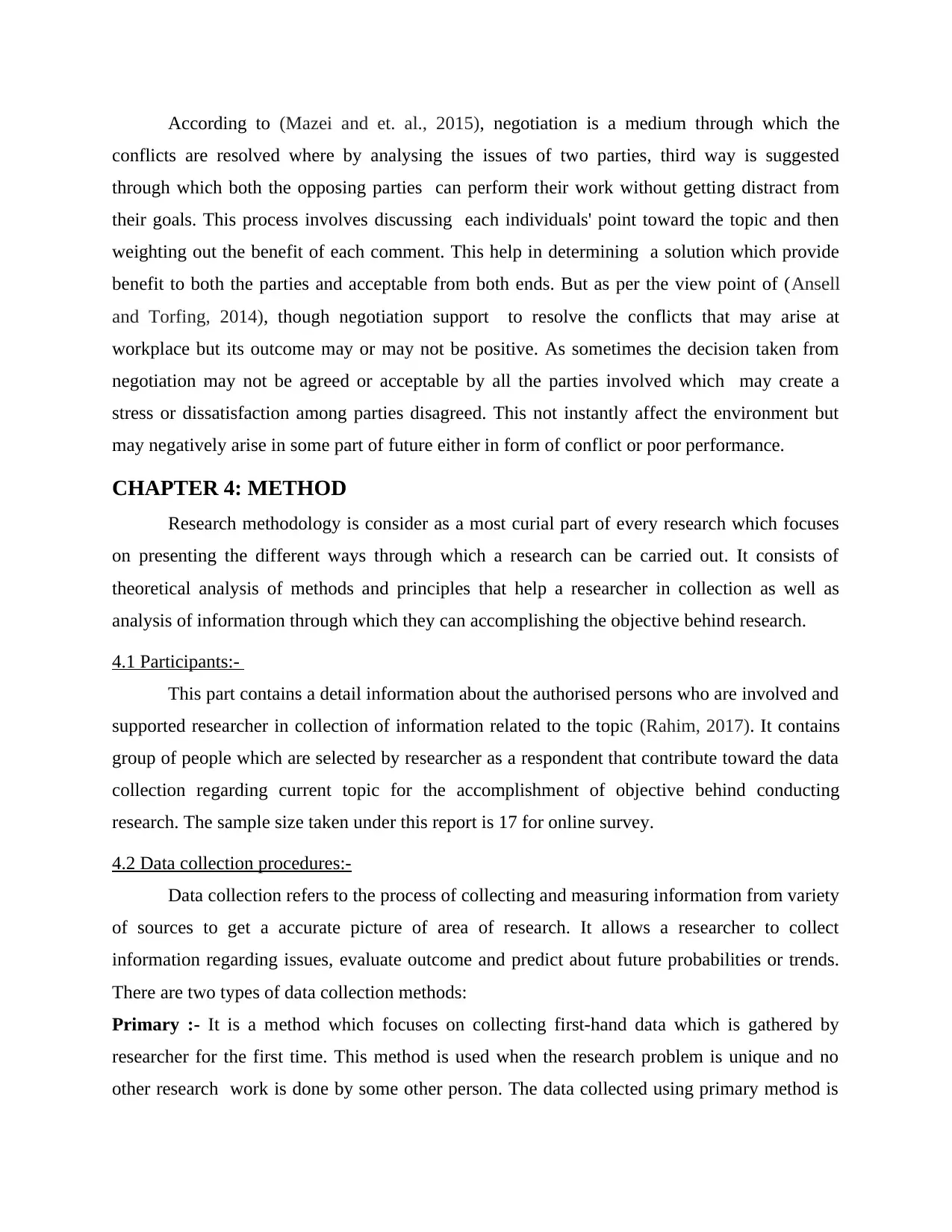
According to (Mazei and et. al., 2015), negotiation is a medium through which the
conflicts are resolved where by analysing the issues of two parties, third way is suggested
through which both the opposing parties can perform their work without getting distract from
their goals. This process involves discussing each individuals' point toward the topic and then
weighting out the benefit of each comment. This help in determining a solution which provide
benefit to both the parties and acceptable from both ends. But as per the view point of (Ansell
and Torfing, 2014), though negotiation support to resolve the conflicts that may arise at
workplace but its outcome may or may not be positive. As sometimes the decision taken from
negotiation may not be agreed or acceptable by all the parties involved which may create a
stress or dissatisfaction among parties disagreed. This not instantly affect the environment but
may negatively arise in some part of future either in form of conflict or poor performance.
CHAPTER 4: METHOD
Research methodology is consider as a most curial part of every research which focuses
on presenting the different ways through which a research can be carried out. It consists of
theoretical analysis of methods and principles that help a researcher in collection as well as
analysis of information through which they can accomplishing the objective behind research.
4.1 Participants:-
This part contains a detail information about the authorised persons who are involved and
supported researcher in collection of information related to the topic (Rahim, 2017). It contains
group of people which are selected by researcher as a respondent that contribute toward the data
collection regarding current topic for the accomplishment of objective behind conducting
research. The sample size taken under this report is 17 for online survey.
4.2 Data collection procedures:-
Data collection refers to the process of collecting and measuring information from variety
of sources to get a accurate picture of area of research. It allows a researcher to collect
information regarding issues, evaluate outcome and predict about future probabilities or trends.
There are two types of data collection methods:
Primary :- It is a method which focuses on collecting first-hand data which is gathered by
researcher for the first time. This method is used when the research problem is unique and no
other research work is done by some other person. The data collected using primary method is
conflicts are resolved where by analysing the issues of two parties, third way is suggested
through which both the opposing parties can perform their work without getting distract from
their goals. This process involves discussing each individuals' point toward the topic and then
weighting out the benefit of each comment. This help in determining a solution which provide
benefit to both the parties and acceptable from both ends. But as per the view point of (Ansell
and Torfing, 2014), though negotiation support to resolve the conflicts that may arise at
workplace but its outcome may or may not be positive. As sometimes the decision taken from
negotiation may not be agreed or acceptable by all the parties involved which may create a
stress or dissatisfaction among parties disagreed. This not instantly affect the environment but
may negatively arise in some part of future either in form of conflict or poor performance.
CHAPTER 4: METHOD
Research methodology is consider as a most curial part of every research which focuses
on presenting the different ways through which a research can be carried out. It consists of
theoretical analysis of methods and principles that help a researcher in collection as well as
analysis of information through which they can accomplishing the objective behind research.
4.1 Participants:-
This part contains a detail information about the authorised persons who are involved and
supported researcher in collection of information related to the topic (Rahim, 2017). It contains
group of people which are selected by researcher as a respondent that contribute toward the data
collection regarding current topic for the accomplishment of objective behind conducting
research. The sample size taken under this report is 17 for online survey.
4.2 Data collection procedures:-
Data collection refers to the process of collecting and measuring information from variety
of sources to get a accurate picture of area of research. It allows a researcher to collect
information regarding issues, evaluate outcome and predict about future probabilities or trends.
There are two types of data collection methods:
Primary :- It is a method which focuses on collecting first-hand data which is gathered by
researcher for the first time. This method is used when the research problem is unique and no
other research work is done by some other person. The data collected using primary method is
⊘ This is a preview!⊘
Do you want full access?
Subscribe today to unlock all pages.

Trusted by 1+ million students worldwide
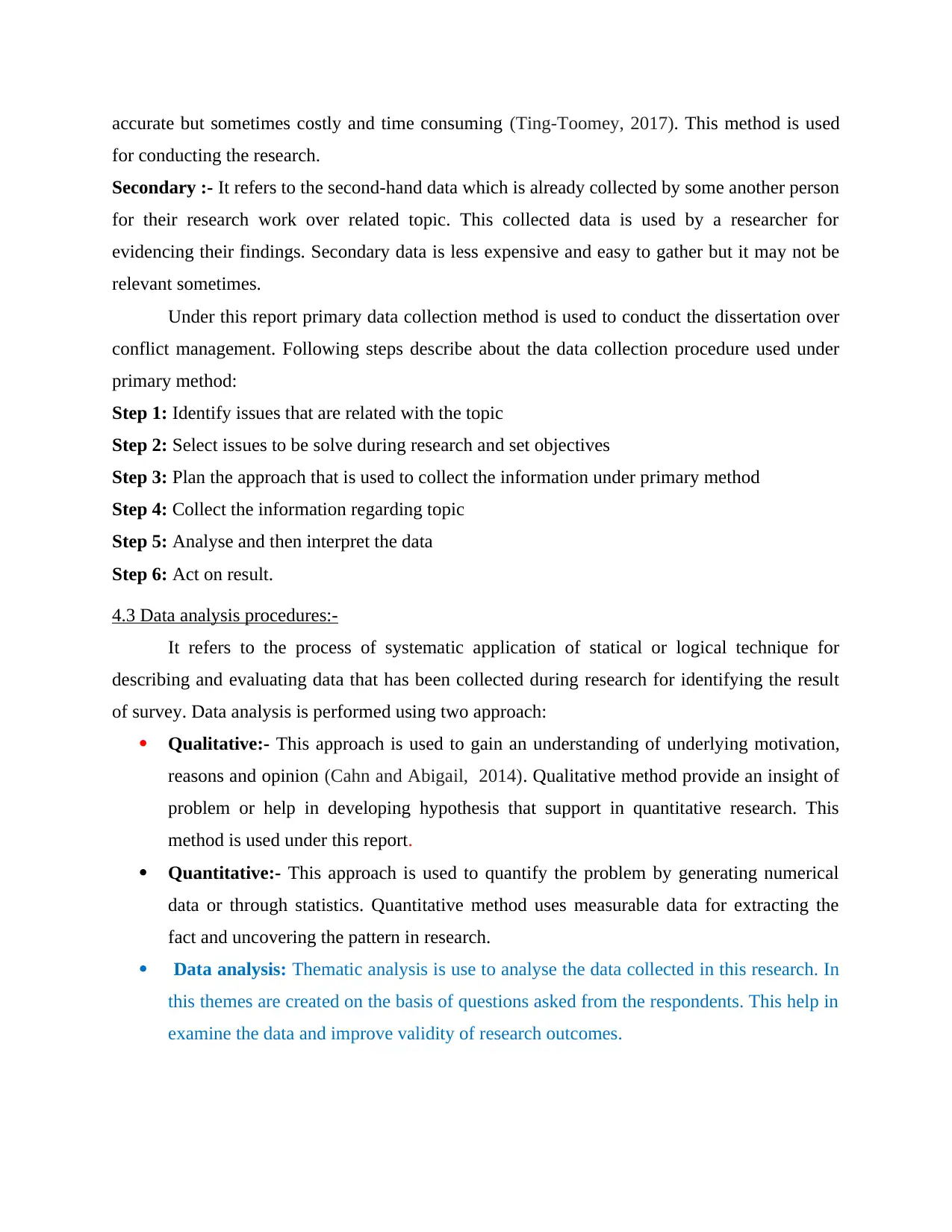
accurate but sometimes costly and time consuming (Ting‐Toomey, 2017). This method is used
for conducting the research.
Secondary :- It refers to the second-hand data which is already collected by some another person
for their research work over related topic. This collected data is used by a researcher for
evidencing their findings. Secondary data is less expensive and easy to gather but it may not be
relevant sometimes.
Under this report primary data collection method is used to conduct the dissertation over
conflict management. Following steps describe about the data collection procedure used under
primary method:
Step 1: Identify issues that are related with the topic
Step 2: Select issues to be solve during research and set objectives
Step 3: Plan the approach that is used to collect the information under primary method
Step 4: Collect the information regarding topic
Step 5: Analyse and then interpret the data
Step 6: Act on result.
4.3 Data analysis procedures:-
It refers to the process of systematic application of statical or logical technique for
describing and evaluating data that has been collected during research for identifying the result
of survey. Data analysis is performed using two approach:
Qualitative:- This approach is used to gain an understanding of underlying motivation,
reasons and opinion (Cahn and Abigail, 2014). Qualitative method provide an insight of
problem or help in developing hypothesis that support in quantitative research. This
method is used under this report.
Quantitative:- This approach is used to quantify the problem by generating numerical
data or through statistics. Quantitative method uses measurable data for extracting the
fact and uncovering the pattern in research.
Data analysis: Thematic analysis is use to analyse the data collected in this research. In
this themes are created on the basis of questions asked from the respondents. This help in
examine the data and improve validity of research outcomes.
for conducting the research.
Secondary :- It refers to the second-hand data which is already collected by some another person
for their research work over related topic. This collected data is used by a researcher for
evidencing their findings. Secondary data is less expensive and easy to gather but it may not be
relevant sometimes.
Under this report primary data collection method is used to conduct the dissertation over
conflict management. Following steps describe about the data collection procedure used under
primary method:
Step 1: Identify issues that are related with the topic
Step 2: Select issues to be solve during research and set objectives
Step 3: Plan the approach that is used to collect the information under primary method
Step 4: Collect the information regarding topic
Step 5: Analyse and then interpret the data
Step 6: Act on result.
4.3 Data analysis procedures:-
It refers to the process of systematic application of statical or logical technique for
describing and evaluating data that has been collected during research for identifying the result
of survey. Data analysis is performed using two approach:
Qualitative:- This approach is used to gain an understanding of underlying motivation,
reasons and opinion (Cahn and Abigail, 2014). Qualitative method provide an insight of
problem or help in developing hypothesis that support in quantitative research. This
method is used under this report.
Quantitative:- This approach is used to quantify the problem by generating numerical
data or through statistics. Quantitative method uses measurable data for extracting the
fact and uncovering the pattern in research.
Data analysis: Thematic analysis is use to analyse the data collected in this research. In
this themes are created on the basis of questions asked from the respondents. This help in
examine the data and improve validity of research outcomes.
Paraphrase This Document
Need a fresh take? Get an instant paraphrase of this document with our AI Paraphraser
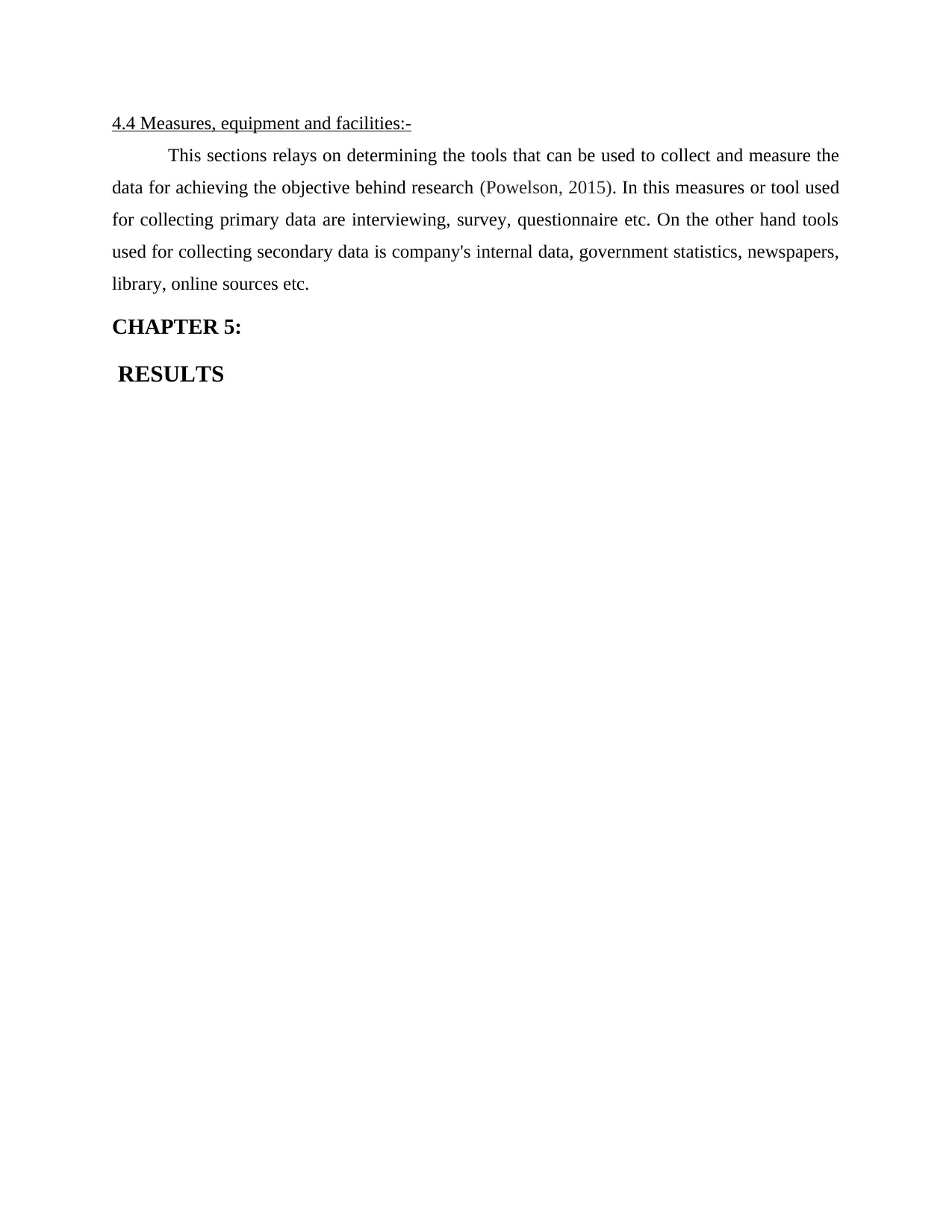
4.4 Measures, equipment and facilities:-
This sections relays on determining the tools that can be used to collect and measure the
data for achieving the objective behind research (Powelson, 2015). In this measures or tool used
for collecting primary data are interviewing, survey, questionnaire etc. On the other hand tools
used for collecting secondary data is company's internal data, government statistics, newspapers,
library, online sources etc.
CHAPTER 5:
RESULTS
This sections relays on determining the tools that can be used to collect and measure the
data for achieving the objective behind research (Powelson, 2015). In this measures or tool used
for collecting primary data are interviewing, survey, questionnaire etc. On the other hand tools
used for collecting secondary data is company's internal data, government statistics, newspapers,
library, online sources etc.
CHAPTER 5:
RESULTS
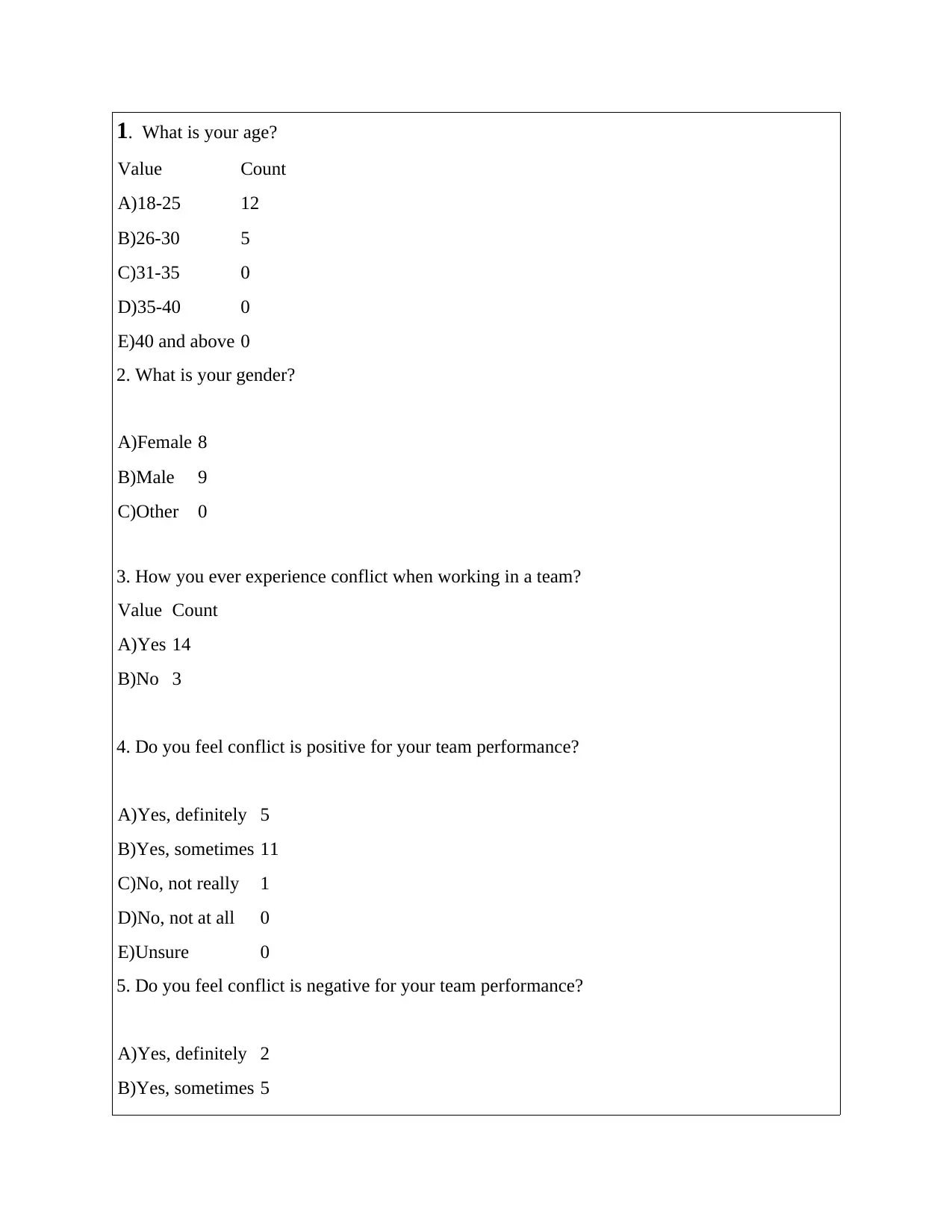
1. What is your age?
Value Count
A)18-25 12
B)26-30 5
C)31-35 0
D)35-40 0
E)40 and above 0
2. What is your gender?
A)Female 8
B)Male 9
C)Other 0
3. How you ever experience conflict when working in a team?
Value Count
A)Yes 14
B)No 3
4. Do you feel conflict is positive for your team performance?
A)Yes, definitely 5
B)Yes, sometimes 11
C)No, not really 1
D)No, not at all 0
E)Unsure 0
5. Do you feel conflict is negative for your team performance?
A)Yes, definitely 2
B)Yes, sometimes 5
Value Count
A)18-25 12
B)26-30 5
C)31-35 0
D)35-40 0
E)40 and above 0
2. What is your gender?
A)Female 8
B)Male 9
C)Other 0
3. How you ever experience conflict when working in a team?
Value Count
A)Yes 14
B)No 3
4. Do you feel conflict is positive for your team performance?
A)Yes, definitely 5
B)Yes, sometimes 11
C)No, not really 1
D)No, not at all 0
E)Unsure 0
5. Do you feel conflict is negative for your team performance?
A)Yes, definitely 2
B)Yes, sometimes 5
⊘ This is a preview!⊘
Do you want full access?
Subscribe today to unlock all pages.

Trusted by 1+ million students worldwide
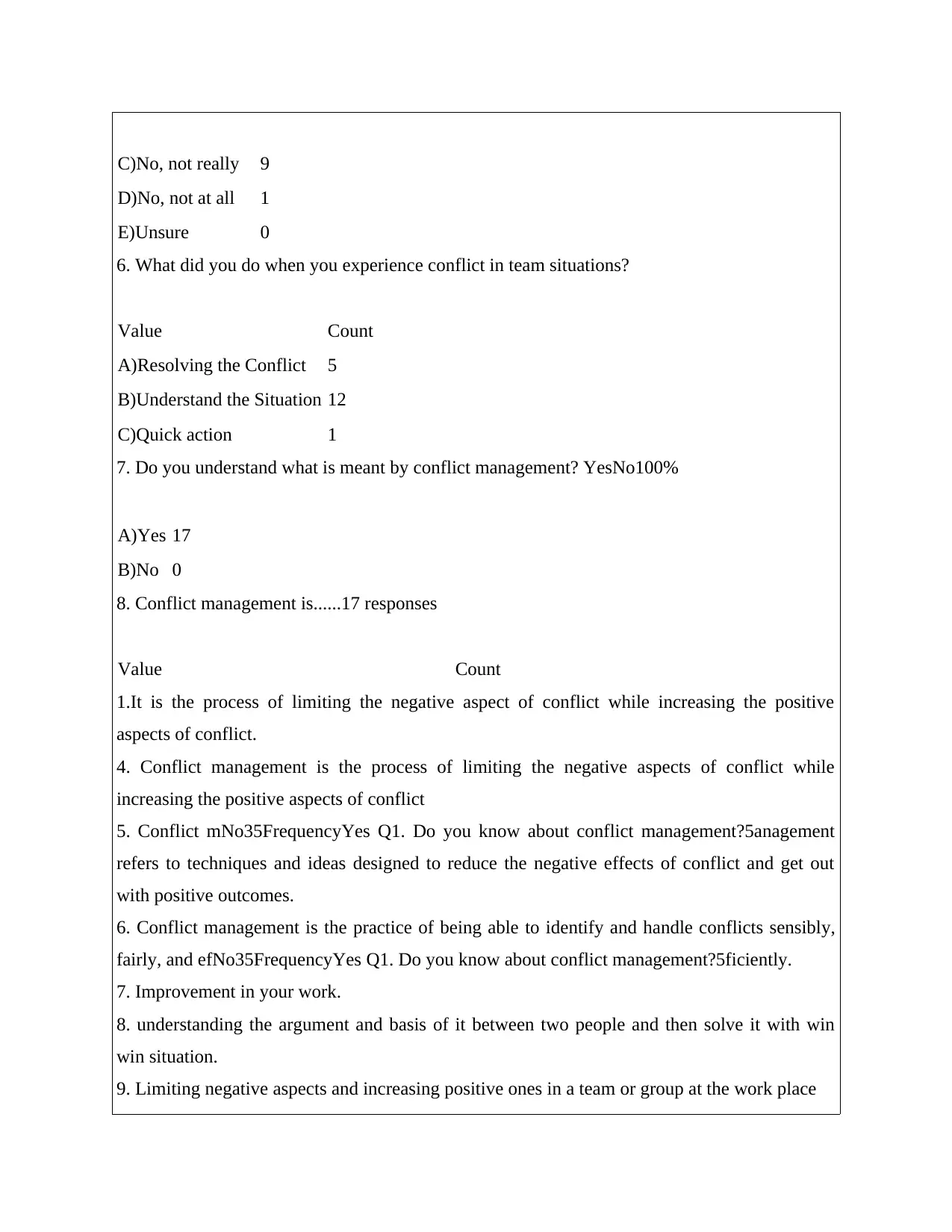
C)No, not really 9
D)No, not at all 1
E)Unsure 0
6. What did you do when you experience conflict in team situations?
Value Count
A)Resolving the Conflict 5
B)Understand the Situation 12
C)Quick action 1
7. Do you understand what is meant by conflict management? YesNo100%
A)Yes 17
B)No 0
8. Conflict management is......17 responses
Value Count
1.It is the process of limiting the negative aspect of conflict while increasing the positive
aspects of conflict.
4. Conflict management is the process of limiting the negative aspects of conflict while
increasing the positive aspects of conflict
5. Conflict mNo35FrequencyYes Q1. Do you know about conflict management?5anagement
refers to techniques and ideas designed to reduce the negative effects of conflict and get out
with positive outcomes.
6. Conflict management is the practice of being able to identify and handle conflicts sensibly,
fairly, and efNo35FrequencyYes Q1. Do you know about conflict management?5ficiently.
7. Improvement in your work.
8. understanding the argument and basis of it between two people and then solve it with win
win situation.
9. Limiting negative aspects and increasing positive ones in a team or group at the work place
D)No, not at all 1
E)Unsure 0
6. What did you do when you experience conflict in team situations?
Value Count
A)Resolving the Conflict 5
B)Understand the Situation 12
C)Quick action 1
7. Do you understand what is meant by conflict management? YesNo100%
A)Yes 17
B)No 0
8. Conflict management is......17 responses
Value Count
1.It is the process of limiting the negative aspect of conflict while increasing the positive
aspects of conflict.
4. Conflict management is the process of limiting the negative aspects of conflict while
increasing the positive aspects of conflict
5. Conflict mNo35FrequencyYes Q1. Do you know about conflict management?5anagement
refers to techniques and ideas designed to reduce the negative effects of conflict and get out
with positive outcomes.
6. Conflict management is the practice of being able to identify and handle conflicts sensibly,
fairly, and efNo35FrequencyYes Q1. Do you know about conflict management?5ficiently.
7. Improvement in your work.
8. understanding the argument and basis of it between two people and then solve it with win
win situation.
9. Limiting negative aspects and increasing positive ones in a team or group at the work place
Paraphrase This Document
Need a fresh take? Get an instant paraphrase of this document with our AI Paraphraser
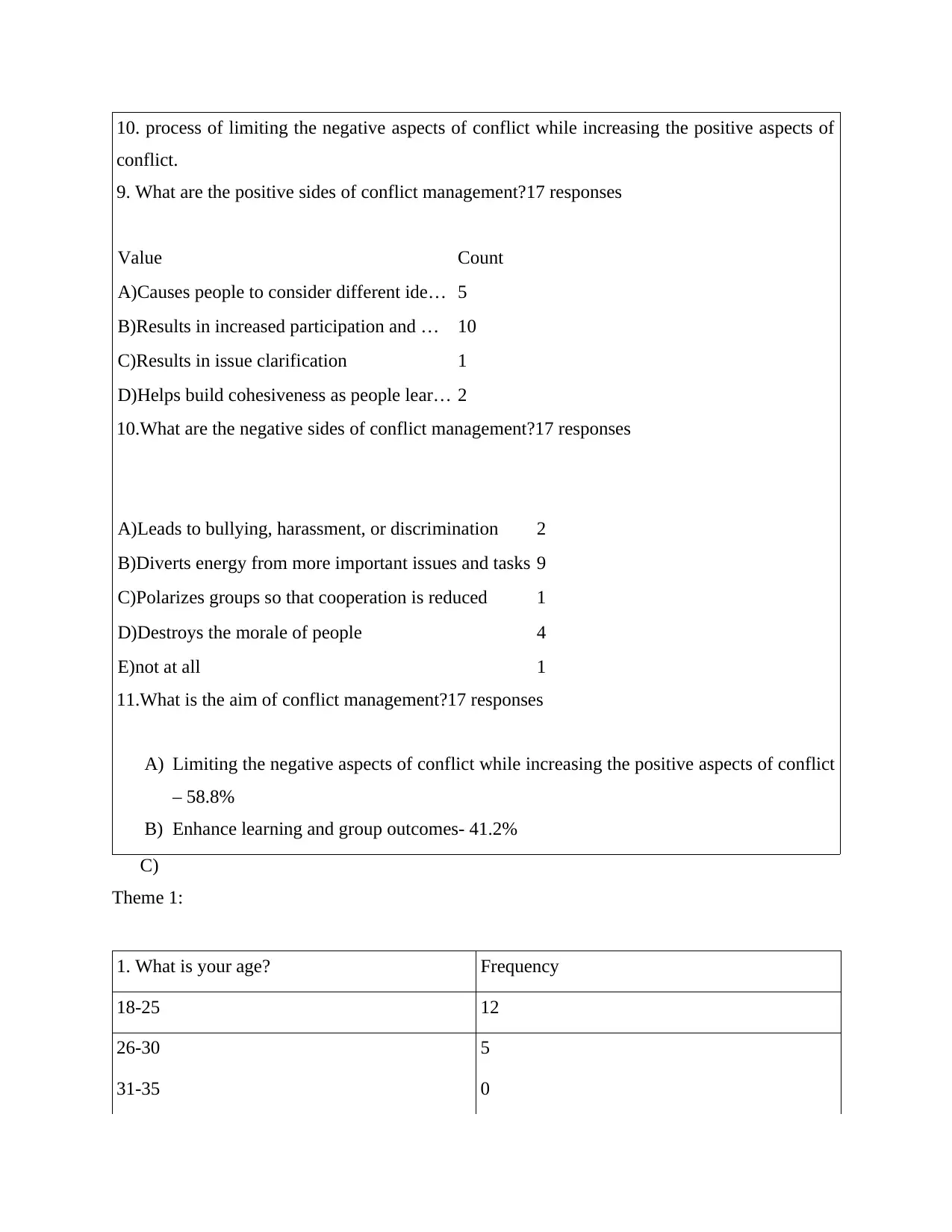
10. process of limiting the negative aspects of conflict while increasing the positive aspects of
conflict.
9. What are the positive sides of conflict management?17 responses
Value Count
A)Causes people to consider different ide… 5
B)Results in increased participation and … 10
C)Results in issue clarification 1
D)Helps build cohesiveness as people lear… 2
10.What are the negative sides of conflict management?17 responses
A)Leads to bullying, harassment, or discrimination 2
B)Diverts energy from more important issues and tasks 9
C)Polarizes groups so that cooperation is reduced 1
D)Destroys the morale of people 4
E)not at all 1
11.What is the aim of conflict management?17 responses
A) Limiting the negative aspects of conflict while increasing the positive aspects of conflict
– 58.8%
B) Enhance learning and group outcomes- 41.2%
C)
Theme 1:
1. What is your age? Frequency
18-25 12
26-30 5
31-35 0
conflict.
9. What are the positive sides of conflict management?17 responses
Value Count
A)Causes people to consider different ide… 5
B)Results in increased participation and … 10
C)Results in issue clarification 1
D)Helps build cohesiveness as people lear… 2
10.What are the negative sides of conflict management?17 responses
A)Leads to bullying, harassment, or discrimination 2
B)Diverts energy from more important issues and tasks 9
C)Polarizes groups so that cooperation is reduced 1
D)Destroys the morale of people 4
E)not at all 1
11.What is the aim of conflict management?17 responses
A) Limiting the negative aspects of conflict while increasing the positive aspects of conflict
– 58.8%
B) Enhance learning and group outcomes- 41.2%
C)
Theme 1:
1. What is your age? Frequency
18-25 12
26-30 5
31-35 0

35-40 0
40 and above 0
Interpretation 1: From the above data it has been concluded that out of 17 respondents 12
respondents are in between age range of 18-25 and remaining 5 respondents are of age range
26-30.
2. What is your gender? Frequency
Female 8
Male 9
Other 0
40 and above 0
Interpretation 1: From the above data it has been concluded that out of 17 respondents 12
respondents are in between age range of 18-25 and remaining 5 respondents are of age range
26-30.
2. What is your gender? Frequency
Female 8
Male 9
Other 0
⊘ This is a preview!⊘
Do you want full access?
Subscribe today to unlock all pages.

Trusted by 1+ million students worldwide
1 out of 23
Related Documents
Your All-in-One AI-Powered Toolkit for Academic Success.
+13062052269
info@desklib.com
Available 24*7 on WhatsApp / Email
![[object Object]](/_next/static/media/star-bottom.7253800d.svg)
Unlock your academic potential
Copyright © 2020–2025 A2Z Services. All Rights Reserved. Developed and managed by ZUCOL.





